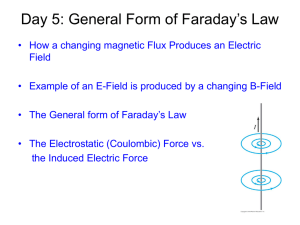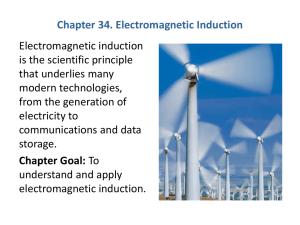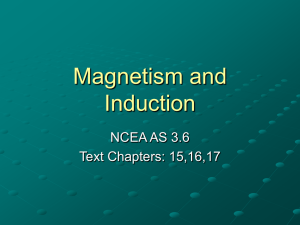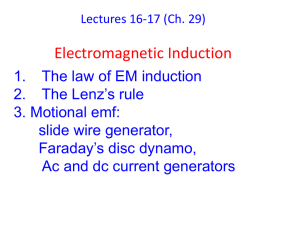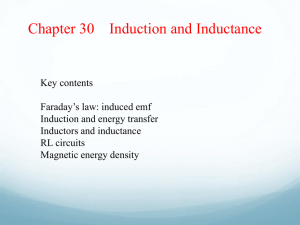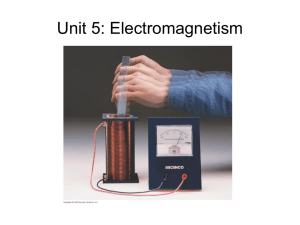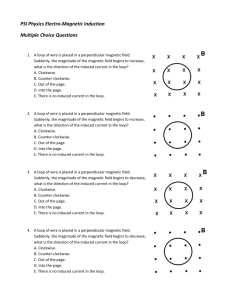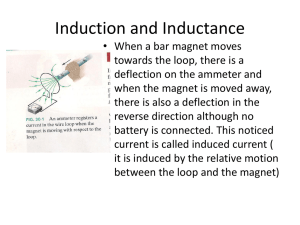lecture14
advertisement
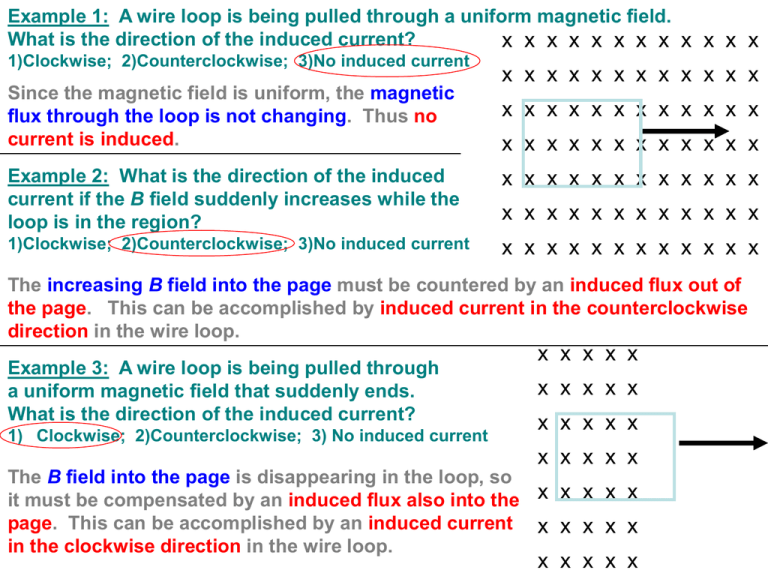
Example 1: A wire loop is being pulled through a uniform magnetic field. What is the direction of the induced current? x x x x x x x x x x x x 1)Clockwise; 2)Counterclockwise; 3)No induced current Since the magnetic field is uniform, the magnetic flux through the loop is not changing. Thus no current is induced. x x x x x x x x x x x x x x x x x x x x x x x x x x x x x x x x x x x x Example 2: What is the direction of the induced current if the B field suddenly increases while the loop is in the region? x x x x x x x x x x x x 1)Clockwise; 2)Counterclockwise; 3)No induced current x x x x x x x x x x x x x x x x x x x x x x x x The increasing B field into the page must be countered by an induced flux out of the page. This can be accomplished by induced current in the counterclockwise direction in the wire loop. Example 3: A wire loop is being pulled through a uniform magnetic field that suddenly ends. What is the direction of the induced current? 1) Clockwise; 2)Counterclockwise; 3) No induced current x x x x x x x x x x x x x x x x x x x x The B field into the page is disappearing in the loop, so it must be compensated by an induced flux also into the x x x x x page. This can be accomplished by an induced current x x x x x in the clockwise direction in the wire loop. x x x x x Example: If a coil is shrinking in a magnetic field pointing into the page, in what direction is the induced current? 1) Clockwise 2) Counterclockwise 3) No induced current The magnetic flux through the loop is decreasing, so the induced B field must try to reinforce it and therefore points in the same direction — into the page. According to the right-hand rule, an induced clockwise current will generate a magnetic field into the page. Example: If a coil is rotated as shown, in a magnetic field pointing to the left, in what direction is the induced current? 1) Clockwise 2) Counterclockwise 3) No induced current As the coil is rotated into the B field, the magnetic flux through it increases. According to Lenz’s Law, the induced B field has to oppose this increase, thus the new B field points to the right. An induced counterclockwise current produces just such a B field. 8b. EMF induced in a moving conductor A lx lvt v l B A x v t B BA t t Blv 1) What is polarity of EMF ? 2) What would be the direction of the induced current, if rod slides on a conducting track ? The B field points out of the page. The flux is increasing since the area is increasing. The induced B field opposes this change and therefore points into the page. Thus, the induced current runs clockwise according to the right-hand rule. FE B FB FE qE v FB qvB Another method: qE qvB E vB El Blv Example: A uniform magnetic field B is perpendicular to the area bounded by the U shaped conductor and a movable metal rod of length l. The rod is moving along the conductor at a speed v. The total resistance of the loop is R. What is the induced emf, the current in the loop, the magnetic force on the moving rod, and power needed to move the rod? Given : B , l , v, R Find : , I, F, P Blv Blv I R R Blv B 2l 2 v F IlB lB R R B 2l 2 v 2 Pext Fv R 2 2 2 2 Blv B l v 2 Pdis I R R R R Example 1: A wire loop is being pulled away from a current-carrying wire. What is the direction of the induced current in the loop? 1) Clockwise 2) Counterclockwise 3) No induced current I The magnetic flux is into the page on the right side of the wire and decreasing due to the fact that the loop is being pulled away. By Lenz’s Law, the induced B field will oppose this decrease. Thus, the new B field points into the page, which requires an induced clockwise current to produce such a B field. Example 2: What is the induced current if the wire loop moves down? 1) Clockwise 2) Counterclockwise 3) No induced current The magnetic flux through the loop is not changing as it moves parallel to the wire. Therefore, there is no induced current. I Example: A wire loop is in a uniform magnetic field. Current flows in the wire loop, as shown. What does the loop do? (1) (2) (3) (4) (5) moves to the right moves up remains motionless rotates moves out of the page There is no magnetic force on the top and bottom legs, since they are parallel to the B field. However, the magnetic force on the right side is into the page, and the magnetic force on the left side is out of the page. Therefore, the entire loop will tend to rotate. This is how a motor works !! 8c. Transformers B1 Vp N p t B1 Vs N s t Vs Ns Vp N p Pp I pV p Pp Ps Is N p I p Ns Ps I sVs 1A Example: What is the voltage across the lightbulb? 120 V 240 V 120 V The first transformer has a 2:1 ratio of turns, so the voltage doubles. But the second transformer has a 1:2 ratio, so the voltage is halved again. Therefore, the end result is the same as the original voltage. Example: Given that the intermediate current is 1 A, what is the current through the lightbulb? Power in = Power out 240 V 1 A = 120 V ??? The unknown current is 2 A. Example: A 6 V battery is connected to one side of a transformer. Compared to the voltage drop across coil 1, the voltage across coil 2 is: Batteries provide DC current. 1 2 Only a changing magnetic flux induces an EMF. Therefore, the voltage across coil 2 is zero.

